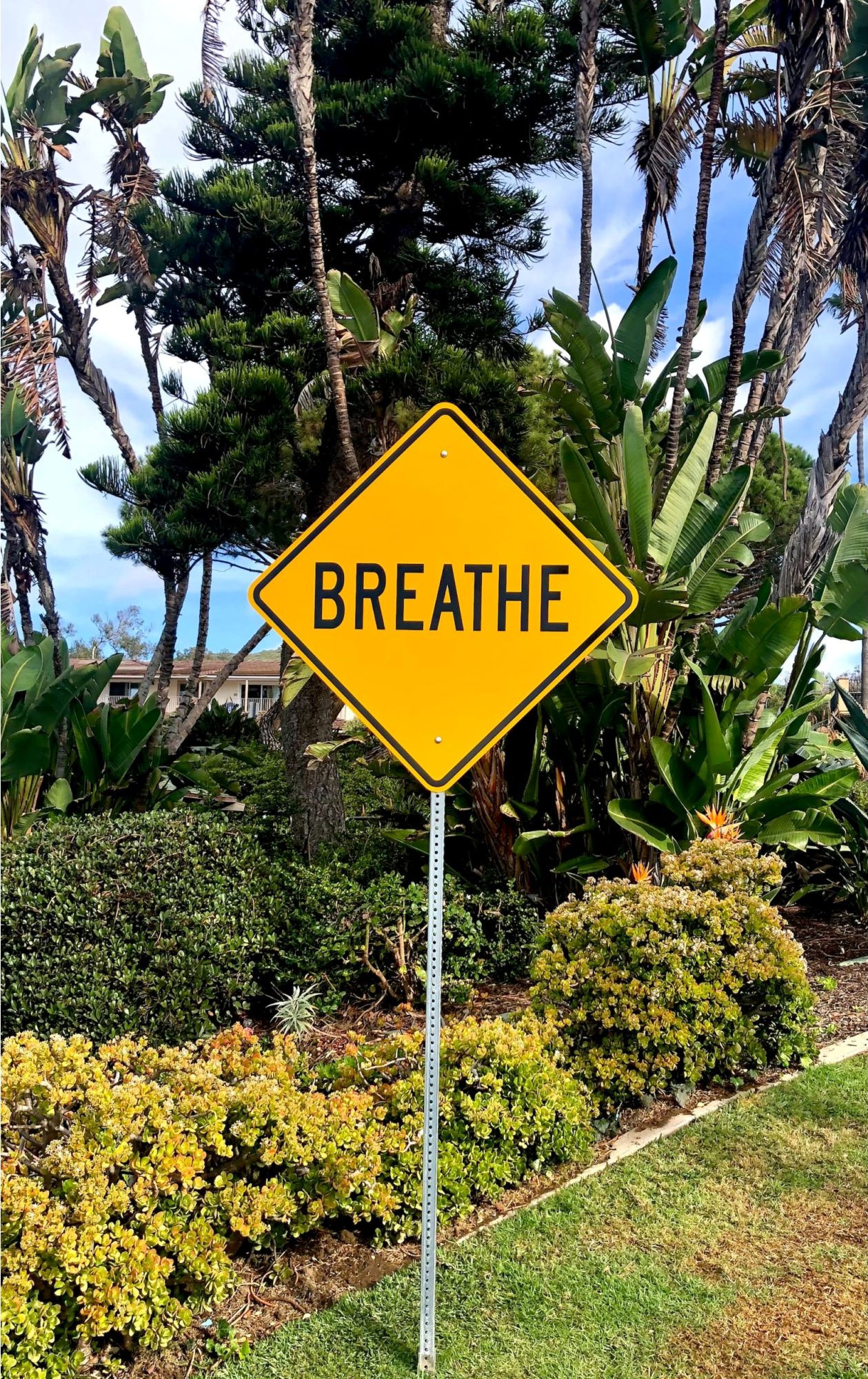 Breathing is a unique process that is both automatic and controllable. Even though it is something you usually do subconsciously and tend to take for granted, the way you breathe can be adjusted and manipulated.
Breathing is a unique process that is both automatic and controllable. Even though it is something you usually do subconsciously and tend to take for granted, the way you breathe can be adjusted and manipulated.
Studies indicate that paying attention to how you are breathing can have a major impact on your stress levels. They have shown that a state of anxiety or panic can be induced just by purposefully hyperventilating, which is taking short, shallow breaths from your chest. Deep breathing, on the other hand, has been found to have a calming effect.
Shallow breathing versus deep breathing.
There are two types of breathing patterns – abdominal (diaphragmatic) breathing, and chest (thoracic) breathing.
Abdominal breathing is deep and even. It engages your diaphragm and allows your lungs to expand and fill with air, enabling more oxygen to flow through your body and into your brain. It’s the way newborns breathe, and also typically the way you breathe when you’re in a relaxed stage of deep sleep.
Chest breathing, on the other hand, is fast and shallow. It causes your body to take in too much oxygen, which can leave you panicky and gasping for air, and signals to your brain that there is a threat.
Most people aren’t really conscious of the way they breathe. To determine your pattern, put one hand on your abdomen and the other hand on your chest. If you are breathing properly, your abdomen should expand and contract with each breath, while the hand on your chest should rise very little.
How deep breathing for anxiety calms you down.
According to Kristoffer Rhoads, a clinical neuropsychologist at the University of Washington Medicine Memory and Brain Wellness Center, your breath is key to your body’s stress response. The reason why deep breathing for anxiety can calm you down has to do with how your nervous system functions.
The act of breathing is regulated by your autonomic nervous system, which also controls other involuntary actions such as your heart rate, and digestion. It consists of two parts – the sympathetic nervous system, which controls your fight or flight response, and the parasympathetic nervous system, which is in charge of your relaxation response.
Both parts of your autonomic nervous system are always active. Although it is not possible to completely turn off the sympathetic system, long, deep breaths can help turn down the volume and quiet it by slowing your heart rate and reducing your blood pressure, which in turn helps reduce your feelings of anxiety.
Practicing deep breathing for anxiety.
 Deep breathing for anxiety involves taking deep, slow breaths from your abdomen to counter the shallow, rapid chest breaths to which you default when stressed or anxious. When you breathe deeply you take fewer breaths per minute and take in more air with each breath, which quiets your sympathetic nervous system and signals your brain to calm down. It is a simple process, but not necessarily easy. It requires practice so it becomes second nature, and you can automatically resort to it in times of stress.
Deep breathing for anxiety involves taking deep, slow breaths from your abdomen to counter the shallow, rapid chest breaths to which you default when stressed or anxious. When you breathe deeply you take fewer breaths per minute and take in more air with each breath, which quiets your sympathetic nervous system and signals your brain to calm down. It is a simple process, but not necessarily easy. It requires practice so it becomes second nature, and you can automatically resort to it in times of stress.
There are several different deep breathing exercises you can try that help manage your anxiety by slowing your heart rate and calming you down. The following are some of the most common ones. Find the technique that works best for you and practice it once or twice a day.
Keep at it until it becomes second nature. Practicing breathing exercises regularly can equip you to automatically shift to this type of breathing at the first signs of anxiety. It is important to inhale through your nose and exhale out from your mouth.
Simple deep breathing.
Simple deep breathing involves taking fewer breaths a minute and taking in more air with each breath.
- Slowly inhale through your nose, feeling your belly expand while your chest remains still.
- Breathe out of your mouth slowly and completely.
- Repeat.
Belly breathing.
Belly breathing, also known as diaphragmatic or abdominal breathing, can be done sitting down, standing, or lying on your back. However, lying on your back is the best position in which to learn how to do it.
- Place one hand on your belly just below your ribs, and the other hand on your chest.
- Breathe in slowly and deeply through your nose, feeling your belly push out while your chest barely moves at all.
- Purse your lips and slowly exhale through your mouth, feeling your belly move inward as the air gets pushed out.
- Repeat.
Box breathing.
Box breathing, also known as square breathing, engages both your mind and body. It can be done seated or lying down. Not only does it stabilize your breath, but it also helps ground you and take your focus off your anxious thoughts.
- With your eyes closed, slowly breathe in through your nose to the count of four.
- Hold your breath for a count of four.
- Slowly exhale through your mouth for a count of four.
- Hold your breath for a count of four.
- Repeat.
4-7-8 breathing.
4-7-8 breathing can be done in any position, but it’s best to sit with your back straight while learning how to do it.
- Start by exhaling through your mouth while making an audible whooshing sound.
- Breathe in through your nose for a count of four.
- Hold your breath for a count of seven.
- Exhale through your mouth, making an audible whooshing sound, for a count of eight.
- Repeat the cycle three more times.
Equal time breathing.
Equal time breathing is a simpler version of box breathing that focuses on matching your inhales and exhales, but does not include the breath holds. It can be done in any position. Start with a count of five, and gradually work up to a count of ten.
- Inhale through your nose for a count of five.
- Exhale through your mouth for a count of five.
- Repeat.
Resonant breathing.
Resonant breathing is similar to equal time breathing, and can be done in any position. However, it has a specific goal of getting you to breathe at a rate of five breaths a minute in a rhythmic pattern
- Breathe in slowly for a count of six.
- Exhale slowly for a count of six.
- Repeat as many times as you want.
Mindful breathing.
Mindful breathing involves breathing deeply and slowly while focusing on your breath. It helps control racing thoughts by grounding you and keeping you centered in the present moment.
- Sit with feet flat on the ground and eyes closed.
- Let your shoulders drop down, away from your ears, and relax your posture.
- Put your hands on your belly with fingertips touching, and breathe slowly and naturally, focusing on the sensation of your breath coming into your body as you inhale, and going out as you exhale. Notice how your belly pushes your hands apart on the inhale, and sinks back as you release your breath. Imagine it as a balloon filling and emptying.
- Repeat.
Breath prayers.
Breath prayers combine deep breathing with a short prayer to help calm your body while focusing your mind on the truth of God’s Word. The prayer is broken into two halves and prayed in rhythm with your breath, the first half while inhaling and the second half while exhaling. Following is an example using Psalm 23:1.
- Breathe in slowly and deeply through your nose while focusing your thoughts on: Lord, You are my shepherd.
- Exhale from your mouth slowly as you focus your thoughts on: I have all that I need.
- Repeat several times while keeping your breathing slow and steady, and meditating on the words of the prayer.
Experiential breathing.
 For an added experience, adding movements or exercises into your breathing techniques can further your resolve. Three examples would be doing squats, push-ups, or walking. Adding movements while breathing can increase your heart rate in a positive way, which will further bring increased oxygen to your mind and body, along with the happy chemicals that bring lasting relief.
For an added experience, adding movements or exercises into your breathing techniques can further your resolve. Three examples would be doing squats, push-ups, or walking. Adding movements while breathing can increase your heart rate in a positive way, which will further bring increased oxygen to your mind and body, along with the happy chemicals that bring lasting relief.
An increased heart rate from anxiety, or other fight, flight or freeze responses, increases chemicals into your brain and body that do anything but bring relaxation and calmness to your being. Using proper body mechanics, all exercise movements can fit your personal needs and capabilities. All of these movements can be modified to suit your personal ability.
Your heart rate should be increased by your physical effort. It is okay to take a slow, long breath or two between each full exercise count. Remember it is not a race to finish. The main focus is structured breathing.
Squats
- Take a short breath to focus on the movement to come.
- Begin to slowly inhale as you lower yourself to the proper lower squat form. Try to go as slow as you can, matching the fullness of your inhale with the end of your lowering motion.
- Pause in the down position for a moment.
- Then begin your exhale as you come up to the starting position. As before, go slow, ending your exhale and physical movement at the same time.
- Again, pause for a moment in between movements.
Continue these steps until you have completed several squats.
Push-ups
Push-ups are conducted the same way as the squats; you are only changing the body mechanic movement. Inhale as you slowly lower yourself, pause, and exhale as you come up.
Walking
- As you begin to walk, slowly inhale for sixto eight steps.
- Pause your breathing for a step or two.
- Then begin to exhale for six to eight steps.
- Pause your breathing for another step or two and repeat.
I recommend walking at a pace that will elevate your heart rate. It might be tricky to find your personal technique at first, but after a few minutes, you will know how fast to walk, and how many steps it will take for each inhale and exhale.
Counting your movements while focusing on your breathing, or vice versa, will also help redirect your thoughts to the here and now, forcing your anxious thoughts elsewhere.
My prayer for you.
 I pray that you would redirect your eyes on the God of our hiding place and refuge. I pray that you would find peace, knowing where your true source of life, comfort, and rest comes from. I pray that in a moment of reflection, you see how easily the world distracts you from what truly belongs to you from an accepted gift, the loving affection, redemption, and a relationship with the Lord and King of all that was and will ever be. Amen.
I pray that you would redirect your eyes on the God of our hiding place and refuge. I pray that you would find peace, knowing where your true source of life, comfort, and rest comes from. I pray that in a moment of reflection, you see how easily the world distracts you from what truly belongs to you from an accepted gift, the loving affection, redemption, and a relationship with the Lord and King of all that was and will ever be. Amen.
If you have questions or would like to set up an appointment to meet with me or one of the other faith-based counselors in our online counselor directory, please give us a call today.
References:
Ankrom, Sheryl. “9 Breathing Exercises to Relieve Anxiety.” Verywell Mind. Updated October 12, 2022. Verywellmind.com/abdominal-breathing-2584115.
Princing, McKenna. “This Is Why Deep Breathing Makes You Feel So Chill.” Right as Rain. September 1, 2021. https://rightasrain.uwmedicine.org/mind/stress/why-deep-breathing-makes-you-feel-so-chill.
“Pause, Breathe, Resume”, Courtesy of Brett Jordan, Unsplash.com, CC0 License; “Breathe”, Courtesy of Bob Osias, Unsplash.com, CC0 License; “Taking a Rest”, Courtesy of Andrea Piacquadio, Pexels.com, CC0 License; “Starting Line”, Courtesy of Mateusz Dach, Pexels.com, CC0 License




